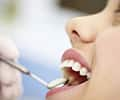Molar Anatomy
The strongest teeth in your mouth are also some of the last to develop. Young children have only a couple of sets of molars. But adults have three sets of molars and smaller teeth called premolars or bicuspids. According to the American Dental Association, first molars typically appear around 6 or 7 years old. The second molars come in between ages 11 and 13.
Wisdom teeth usually come in between 17 and 21 years old. They are called third molars. People typically only need the first and second set, so your dentist might even recommend removing wisdom teeth to avoid overcrowding the mouth.
Molar Function
Molars are very important for eating. While your canine and front teeth bite and tear food into pieces, the back teeth are meant for chewing. They are responsible for breaking down food before swallowing. In fact, they're the teeth most often in contact with food after that initial bite. Their large size and jagged, broad surfaces make them the workhorses of your teeth.
How to Care for Your Molars
Because molars are the teeth most commonly in contact with food, they're also the teeth most susceptible to accumulating food particles and developing cavities. They can also be positioned close together, creating bacteria breeding grounds if food particles and bacteria get caught between them. That's why good oral hygiene is so important.
Care for all your teeth by brushing at least twice daily, making sure to clean every surface of your molars. Clean between your molars daily with floss, water flossers, or other interdental cleaners. Keep your regular dental visits for preventive treatment to prevent gingivitis, tooth decay, and other oral care issues.
If you feel any pain in a molar, see your dentist immediately. It could be a sign of a cavity. Having a cavity filled early helps stop decay in its tracks and protects the root deep inside the molar.
Molars are critical for your health. They help you bite, chew, and eat food comfortably. Preventive care like good oral hygiene habits and reporting any pain or discomfort to your dentist will ensure your molars are in top working order.
Oral Care Center articles are reviewed by an oral health medical professional. This information is for educational purposes only. This content is not intended to be a substitute for professional medical advice, diagnosis or treatment. Always seek the advice of your dentist, physician or other qualified healthcare provider.
ORAL HEALTH QUIZ
What's behind your smile?
Take our Oral Health assessment to get the most from your oral care routine
ORAL HEALTH QUIZ
What's behind your smile?
Take our Oral Health assessment to get the most from your oral care routine
Join Us
Get the best of your oral health routine and take it to the next level with expert advice, recommendations, products and solutions and special offers.
Join Us
Get the best of your oral health routine and take it to the next level with expert advice, recommendations, products and solutions and special offers.















